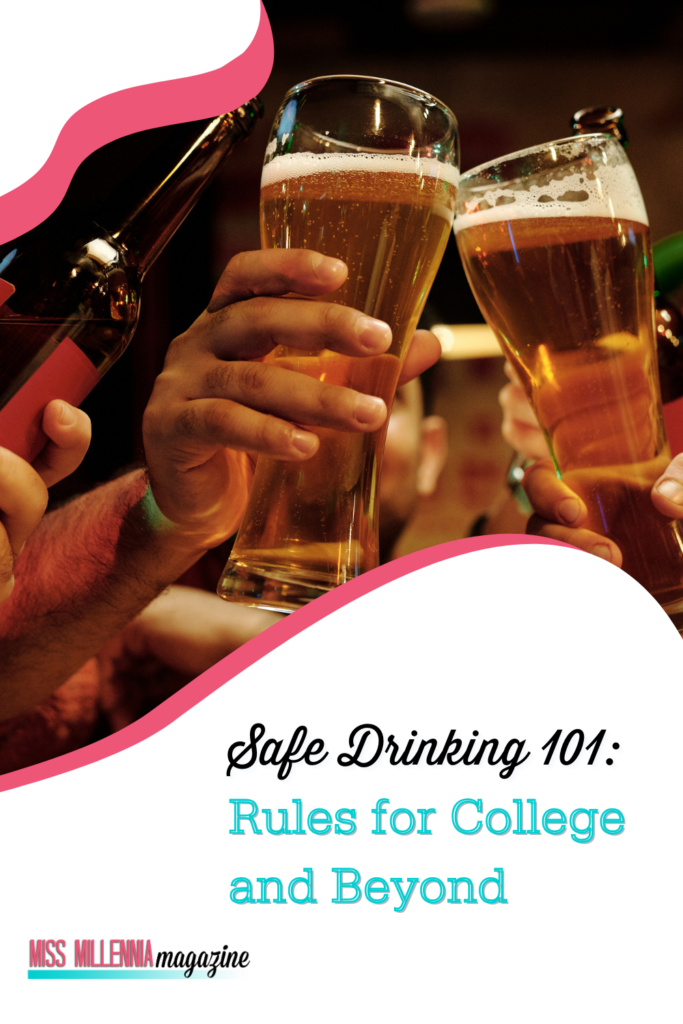Safe Drinking 101: Rules for College and Beyond

If you enjoy an occasional night out with friends, you must understand how to be safe. According to the University of Hawaii at Manoa’s Alcohol Project, there are several ways to practice low-risk drinking. Here are tips that you need to follow to ensure safe drinking when you are in college.
1. Set a Limit
Before you start drinking, decide what your limit will be. Keep in mind the saying, “Know your limits.” Factors to consider are how many people you are with, whether or not you ate a full meal before going out, and how you plan on getting home. For men, the average limit is four drinks; for women, the average is three drinks.
Drinking beyond these limits increases the risk of health problems like liver damage, alcohol misuse, or even loss of consciousness. This is especially important for young adults who are still learning their tolerance and how alcohol affects their bodies.
2. Space Your Drinks
We’ve all been at bars or parties where alcohol is “slammed” and drinks are had in rapid succession. A better idea is to space your drinks by an hour. Drink moderately. Additionally, following each drink with a glass of water will keep you from getting too quickly intoxicated.
Keeping track of your alcohol content is crucial. It’s worth noting that one standard drink is about 14 grams of pure alcohol, which can vary depending on what you’re drinking.
If you find yourself frequently unable to stick to these limits, it may be a sign of deeper issues, and seeking rehab for alcoholism or alcohol misuse can provide the support needed to regain control and establish healthier habits.
3. Forego the Drinking Games
Unless you are sitting at home with a close group of friends and family, skip the drinking games. Find a game that everyone will enjoy.
Though fun, they can also be dangerous, especially if you lose. Most people don’t keep track of just how much they are drinking.
High-intensity drinking, where large amounts of alcohol are consumed in a short time, can lead to severe consequences like alcohol poisoning.
4. Watch Your Drink
Never leave your drink sitting on a bar or table in public. Likewise, don’t leave a drink on your end table if you are entertaining someone you’ve just met. While you may be the trusting sort, people drinking around you may take advantage of an unattended drink.
Carry your drink with you everywhere you go, or wait to get up until you’ve finished your drink. This not only keeps your drink safe but also reduces the likelihood of someone pressuring you to accept more alcohol.
5. Never Accept a Drink from a Stranger
Just as you should never leave your drink unattended, you should never accept a drink from a stranger. If someone offers to buy you a drink, cozy up to the bar, watch it being prepared, and allow your new friend to pay for it.
6. Figure Out Your Transportation
Before leaving the house for your night out, figure out how you’ll get home. You may want to take a cab, have a friend pick you up, or even designate a driver. No matter which you choose, the important thing is that you don’t drive drunk or ride with anyone who has had a drink.
According to the Centers for Disease Control and Prevention, drunk driving remains a significant public health issue, especially among college students. Planning your transportation ensures you can avoid unnecessary risks.
7. Don’t Abandon Anyone
Agree with your group that no one will wander off and no one will be left behind. If you meet someone and can’t resist the urge to go, your pact may keep you in place. Remember that you can always meet that new person the following day or night when you’re both sober. Never leave a friend who has passed out; stay with them or find someone who can.
Alcohol affects body temperature, which can be dangerous for someone unconscious. Leaving a friend alone in such a state increases the risk of serious complications, including hypothermia or worse.
8. Avoid Alcohol When Necessary
It’s essential to recognize times when it’s better to avoid alcohol entirely. Certain times, like early mornings before classes or essential events, may not be appropriate for drinking. Additionally, if you notice someone struggling with alcohol dependency, encourage them to seek help and support them if they decide to seek treatment or stop drinking.
Final Thoughts on Safe Drinking
Drinking to excess can be dangerous to your health. Not only do you run the risk of being sexually assaulted, injured, or even killed, but you also increase the chance of developing serious health issues over time. This includes long-term effects like liver damage, cardiovascular problems, and addiction.
The Department of Health stresses the importance of responsible drinking to minimize these risks. Practicing safe drinking and understanding the dangers of alcohol misuse are critical steps toward maintaining your well-being while enjoying social activities. Following these tips on low-risk drinking can help keep you healthy, uninjured, and alive.







